

Most first flights last about 20 minutes. I was lucky. I got into a thermal and climbed the glider to 4000 feet and we stayed up for forty-five minutes. My instructor was Stan Bienada, who had moved from Poland to Canada. At one point I got to cloud base and started into the cloud. Stan grabbed the controls, opened the spoilers and got us out of it. Spoilers are flaps in the middle of the wings that will open and kill the lift of the wings causing the aircraft to sink fairly rapidly. Training gliders are not equipped for instrument flying and getting right into a cloud could be a disaster.
 |
 |
 |
On release from the tow plane I noticed that when I brought the speed to the usual 45 MPH it was making a lot of wind noise. I was sinking quickly so headed back for the landing strip. As I came over the trees I noticed that I was doing 45, but on final should have been at least at 50 MPH. I pushed the stick forward to pick up speed, and seconds later touched down. Where I would usually go about 200 feet before stopping, this time I went about 600. The fellows congratulated me as they ran down to help push the ship back. I said that I thought the single felt like a fighter plane coming in. One said that I was flying it like a fighter, that I was doing about 80 MPH on landing. After it was pushed off to the side the pitot tube was checked and it was found that it was partially filled with sand. I guess that I was doing about 80, very fast for a glider landing.
This went on for awhile and then I noticed that our lift was very strong, still on tow. I released at 2000' and noticed that we were rising with the variometer locked at 1000 FPM. We were approching the cloud base so I opend the spoilers. We were still locked at 1000 FPM so I put the nose down and increased speed to about 65 MPH. Still locked. I opened the spoilers and the variometer finally dropped, to 970 FPM. We were approaching the cloud base and I was getting worried. My next trick would be to go in a spin, but the 2-33 doesn't spin very well. It tends to correct itself. Just as we got to 4700' we started down. As it turned out we had taken off just as a cold front came through and that caused the warm air that we were in to go up fast, probably about 2000' per minute. I asked Jim for his log and he didn't have one. I asked him where he recorded his last three instructional flights and his answer was that he had only had three passenger flight, never an instruction.
 |
 |
 |
I bought my share on 12th May, 1973. The Skylark was built in 1958 and the company that built it stated that it would last ten years. It was already five years past and as of 1999 it is still flying at the same club. In 1958 one of it's kind won the world championship. The wing span is 60 feet with a deep chord. That enabled it to soar with very light lift. By the time I bought it glass ships were around with very shallow chord, long wings. They had something that the Skylark did not, penetration. That means that they could increase speed and not lose height very fast. The Skylark was a good soarer but had poor penetration. As soon as you picked up speed it would sink quickly.
On the purchase date I took it up and got to 3700' and flew for two hours and nine minutes. A series of badges that glider pilots go for start with the Silver "C". The first is a height gain of 1000 meters, the second a flight time of five hours after release from the tow plane and the third a cross country flight of 50 Km and landing that distance from the start point. On the 13th June, 1970 reached 6000', a gain of 4000' for number one, using a 1-26. On 26th August, 1970 I flew 48 miles, landing near the St. Lawrence River in Quebec. On 23rd May, 1973 I tried for the time flight in the Skylark. We always tried to make five and a half hours to ensure that we wouldn't find out on landing that after release we were about five minutes short. I made five hours and twenty-six minutes.
The right picture shows the Skylark in the family room of one of my partners. We didn't like the blue color design and repainted it in white. This was done during the winter of course.
 |
 |
 |
The picture on the right is of the Blanik on the ground, waiting for its next flight. It has flaps, something that most gliders don't have. It's spoilers are not as effective as some, but with flaps and spoilers open together the sink rate is very efficient.
 |
 |
 |
The third picture is of the 2-33, our training glider of that time. I see no tow rope so it looks like it has come to a stop and the pilot is letting the wind flow hold the wings level. The student sits in the fron. He has a canopy that swings up and to the left side of the glider. The instructor sits in the back seat and has a door on the right side of the plane, similar to most power planes.
 |
 |
 |
The first picture above shows a glider just before touch down. The river can be seen ner the bottom of the picture. The second shot shows another glider, a glass one, just turning final in the upper left hand corner while a boat passes on the river in the lower right corner. Glass ships, being more modern, are faster and have better penetration than the older styles. They would actually do their base leg across the river.
The third shot show a woman student pilot on her first solo. She did it just as the sun was setting, the only time I have ever seen this. The left spoiler of the 2-33 can be seen in the open position. This woman later became a partner with myself and two other fellows in the ownership of an ex towplane that we purchased from GGC when they renewed their two. It is a Champion, OGW, which we leased to RVSS to be used as one of their tow planes.
 |
 |
 |
| Tow Pilot | Tow Pilot Signaller | Glider Wing Man |
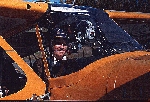 |
 |
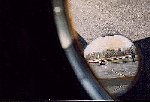 |
| Glider on Tow | From the Glider | Starting a Turn |
 |
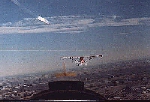 |
 |
| Glider After Release | Approaching Circuit | Nearing Touch Down |
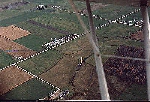 |
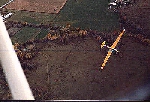 |
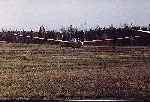 |
| Hauling to the Line | Waiting For Next Flight |
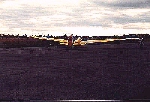 |
 |
The first picture shows me sitting in the tow plane waiting for the hook-up to be made. At the bottom of the picture, by the door, can be seen part of a mirror. Most power planes do not have mirrors but it is required with a tow plane so that the glider can be seen, especially at release when the glider pilot releases so that the tow pilot can immediately make his dive to the left, while the glider pilot climbs to the right..
The man who has just hooked up the tow end is now going to a position ahead and to the left of the plane to duplicate signals received from the wing runner who has hooked up the glider end.
The glider is in position and the wing runner is waiting for a thumbs up from the glider pilot to start the signals to the tow signaller.
The glider can be seen in the mirror in his position behind and the background shows the farm land and crossroads ahead of the tow.
The glider pilot keeps the middle of the tow plane on the horizon to maintain the correct level of flight. Attached to the front of his canopy is a yaw string to indicate whether he is maintaining a co-ordinated flight or is yawing or slipping. Gliders use it in place of a power A/C's ball. The yaw string is more sensitive and easy to answer to.
The two A/C are starting a turn to the left. The tow plane is shown in the correct position on the horizon. The glider pilot should use a little more left rudder to bring the yaw string in line.
After release the tow plane dives to the left and maintains his engine RPM because of the overheating that the engine gains from towing the glider. Because of this he climbs a short distance higher than the glider before he can start to ease back on the throttle to start his descent. In this picture I did an extra turn to get a picture of the glider from above.
The glider is nearing the Initial Point of the down wind leg of his circuit. A circuit consists of the down wind leg, base leg and the final approach.
The glider is a few feet from the ground on his final approach. The single main wheel and the tail wheel can be seen.
Gliders have to be pulled back to the flight line after it has completed its landing, assisted by volunteers on the field.
If no one is ready to go up the glider is pulled off of the line to the side of the runway to wait for it's next flight. Otherwise it would be taken to a position behind any gliders at the beginning of the runway, waiting in a line for their turn. As one tow starts the gliders in the line are moved up into position. The next glider to go is placed on the tarmac while the remainder might be on the grass behind.